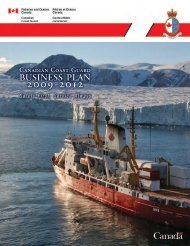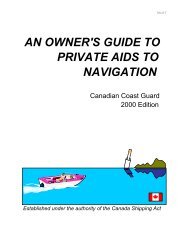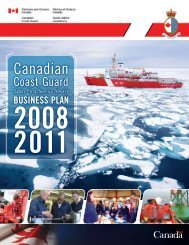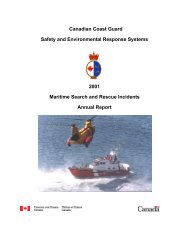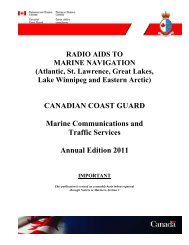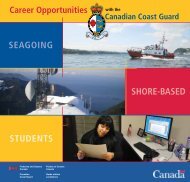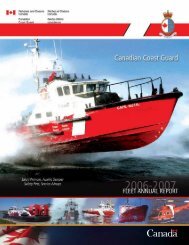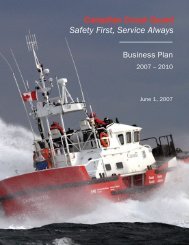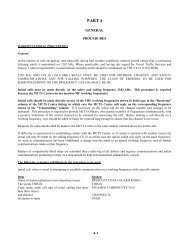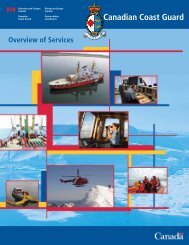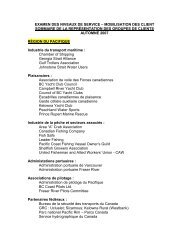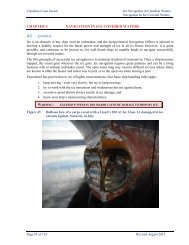RADIO AIDS TO MARINE NAVIGATION - Canadian Coast Guard
RADIO AIDS TO MARINE NAVIGATION - Canadian Coast Guard
RADIO AIDS TO MARINE NAVIGATION - Canadian Coast Guard
You also want an ePaper? Increase the reach of your titles
YUMPU automatically turns print PDFs into web optimized ePapers that Google loves.
Arctic Canada<br />
The Arctic Canada VTS Zone includes those waters of Ungava Bay, Hudson Bay and James Bay south of the parallel of<br />
60 o north latitude and the waters to which the Arctic Waters Pollution Prevention Act apply.<br />
It excludes Mackenzie Bay and Kugmallit Bay south of the parallel of 70° north latitude and east of the meridian of<br />
139° west longitude.<br />
Athabasca – Mackenzie Watershed<br />
From Tuktoyaktuk to Great Slave Lake, danger areas have been designated and reporting procedures established for<br />
vessels in these areas.<br />
ZONE APPLICATION<br />
Western Canada – Offshore<br />
With respect to the Western Canada VTS Zones, the Vessel Traffic Services Zone Regulations require a report to be made<br />
at least 24 hours before the ship enters a VTS Zone from seaward including Alaska, or as soon as possible where the<br />
estimated time of arrival at that VTS Zone is less than 24 hours after the ship departs from the last port of call, where the<br />
ship is:<br />
a) of 500 tons gross tonnage or more;<br />
b) engaged in towing or pushing a vessel, where the combined tonnage of the ship and the vessel being towed or pushed<br />
is 500 tons gross tonnage or more; or<br />
c) carrying a pollutant or dangerous goods, or engaged in towing or pushing a vessel carrying a pollutant or dangerous<br />
goods as prescribed in the;<br />
i) Oil Pollution Prevention Regulations,<br />
ii) Pollutant Substances Regulations<br />
iii) Dangerous Goods Shipping Regulations,<br />
iv) International Maritime Dangerous Goods (IMDG) Code, and<br />
v) Dangerous Chemicals and Noxious Liquid Substances Regulations.<br />
Participation seaward of <strong>Canadian</strong> and U.S. territorial waters for vessels between 300 and 500 tons gross tonnage is<br />
strongly encouraged to receive the benefit of Vessel Traffic Services. The offshore services are typically available to about<br />
50 nautical miles. These benefits include traffic information, warnings of vessel congestion or other hazardous conditions,<br />
and many other forms of transit assistance.<br />
Western Canada – Local VTS Zones<br />
For vessels within or about to enter a Western Canada VTS Zone, the Vessel Traffic Services Zone Regulations apply in<br />
respect of:<br />
a) every ship twenty metres or more in length;<br />
b) every ship engaged in towing or pushing any vessel or object, other than fishing gear, where;<br />
i) the combined length of the ship and any vessel or object towed or pushed by the ship is forty-five metres or more<br />
in length, or<br />
ii) the length of the vessel or object being towed or pushed by the ship is twenty metres or more in length.<br />
3-3



